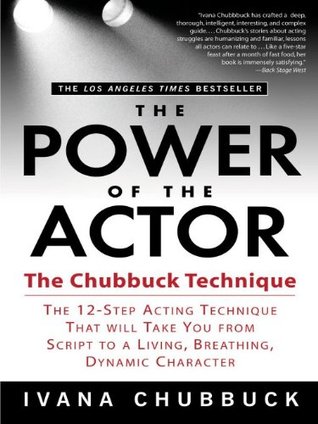Kindle Notes & Highlights
Once you have conjured up as accurate an image as possible, match the shapes of the set with similar shapes that exist in your ex-mate’s living room.
As you endow each significant part of the PLACE, think about events—both traumatic and wonderful—that have taken place in that space.
Do this until you feel like you have transported yourself from the soundstage, acting class or theater to the actual PLACE you’ve chosen.
If you’re doing film or television work, spend at least ten or fifteen minutes on the set of the scene you’re about to shoot.
If the PLACE you choose is too easy to be in, you won’t be compelled to win your SCENE OBJECTIVE.
believe it or not, there are many PLACES in your life that can duplicate the anxiety of being in a space for the first time.
Personalizing what you’re seeing outside your car window in doing car scenes is part of creating PLACE.
Every PLACE from your life has an emotional base.
You must choose a PLACE that has the most powerful emotional connections to produce the highest dramatic intent.
prison can be any PLACE that motivates a sense of being physically and/or emotionally caged.
Michelle used a PLACE where a traumatic childhood event occurred.
Michelle’s PLACE choice gave her the general sense that she had no way out and no one to turn to, the same feeling she had when she was a child experiencing her trauma for the first time.
The FOURTH WALL is the edge of the stage or set.
The FOURTH WALL encloses your PLACE, establishing a sense of intimacy and privacy.
When you are personalizing the floors, walls and furniture of the set from your PLACE choice, you have to personally endow ...
This highlight has been truncated due to consecutive passage length restrictions.
even though the set lacks a literal fourth wall, you must fill out your entire PLACE, spatially duplicating and completing what would be on that wall in your PLACE choice.
Pick big items from your PLACE choice—a window, television, painting, art object, chest of drawers, armoire, etc.—things that are similar in shape to the actual items there so that it’s easy to spatially endow your personal FOURTH WALL.
It’s always important to create privacy in your work, but particularly crucial when doing a highly charged emotional or sexual scene.
If there’s clear space with an audience, as in a theater, just pick some of the more obtrusive items on your FOURTH WALL and imagine them there. Or, if it’s a small theater space, see the wall that actually exists beyond the audience. Then take the actual shapes that exist there and endow the wall with the items that would generally exist there.
you don’t have to imagine each and every item in that PLACE and on that FOURTH WALL.
Just picture the key pieces that define your personal PLACE/ FOURTH WALL—particularly the items that hold some history or special meaning.
if you’ve picked the correct emotionally charged objects to project, they will often inadvertently call up less-charged objects that will flesh out the space you’re endowing.
In an outdoor PLACE, the FOURTH WALL is what would be on the horizon.
In a private/inside PLACE/FOURTH WALL, you are alone with only one or two other people. In this kind of PLACE, anything can be said and done because there’s no one else there to spy, reveal, judge or change the tone of your activity.
includes the privacy of sex, secrets told or experienced, violence or death.
PLACES that are inside but public change the tone of the scene because you can possibly be overheard and/or seen.
always have the OBSTACLE of other - people in the scene discovering and then disclosing what they’ve seen or heard to that person or persons that your character wishes not to know—
When thinking about an inside/public PLACE/FOURTH WALL, it’s helpful to identify exactly who it is that is lurking around your public place, which ups the stakes.
difference between outside/private PLACE/FOURTH WALL(s) and an inside/private PLACE/FOURTH WALL is that when you are outdoors, there’s an even greater possibility that you can be discovered or caught.
In an outside/private PLACE, the FOURTH WALL is the horizon.
Always use what would truly exist in your personal FOURTH WALL of the...
This highlight has been truncated due to consecutive passage length restrictions.
First, endow the inside of the car with a car you’re familiar with, one that brings up the appropriate history to the script.
then you must personalize the scenery, making sure that what you’re passing makes logical sense with the script.
Make a choice for your car and the contiguous area that you see outside the car, double-checking to see if these choices follow and make sense to the linear inner work you’ve already done.
You must not only endow a familiar, emotionally duplicated PLACE/FOURTH WALL from your life with the PLACE/FOURTH WALL you’re actually in, but, as with an inside/public space, you must also use SUBSTITUTION to endow one of the nonspeaking people who are located around you with someone who would emotionally affect you in some way.
PLACE/FOURTH WALL student examples used in movies and television.
PLACE/FOURTH WALL serves to strengthen your emotional reality and the sense of privacy, which helps foster even more feeling.
DOINGS are the physicalization of our intentions through the use of props.
All the things that people do in life are DOINGS—
The handling of props allows you to naturally behave, and the inner work will inform how you handle them.
The use of DOINGS is so powerful that they allow you to convey your rage even if you’re speaking softly.
When the stakes are high, it’s simply impossible to look that person straight in the eye all the time. DOINGS gives you a legitimate reason not to have to face the other person.
when we get scared, upset, angry or excited, we DO.


